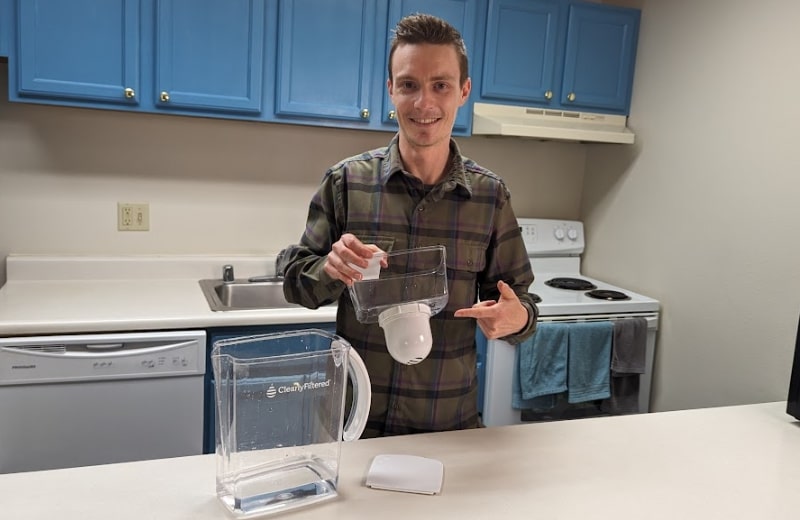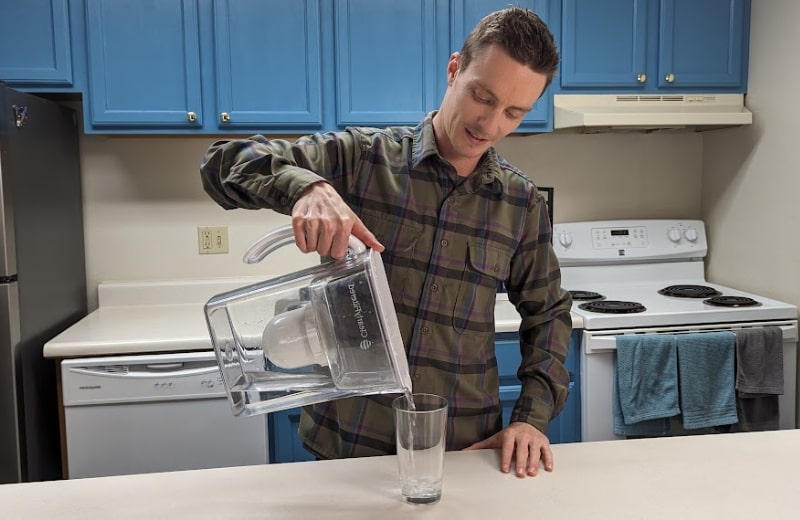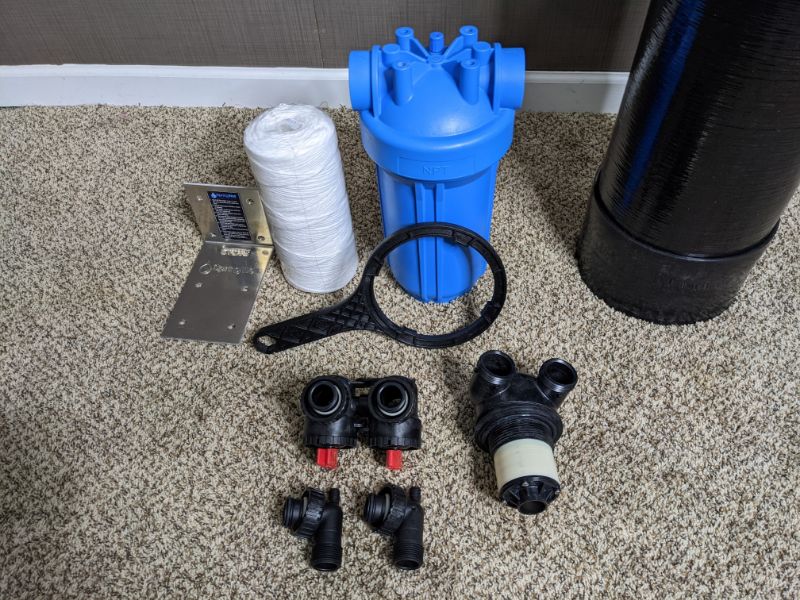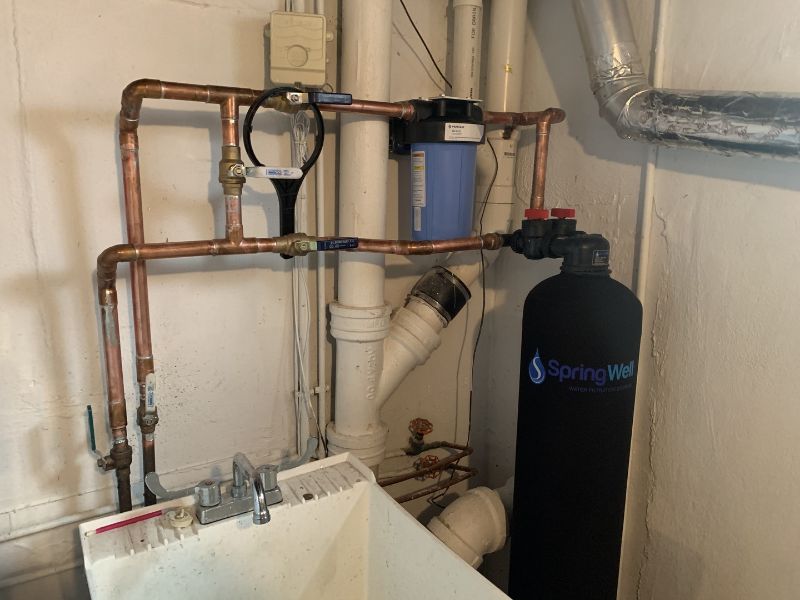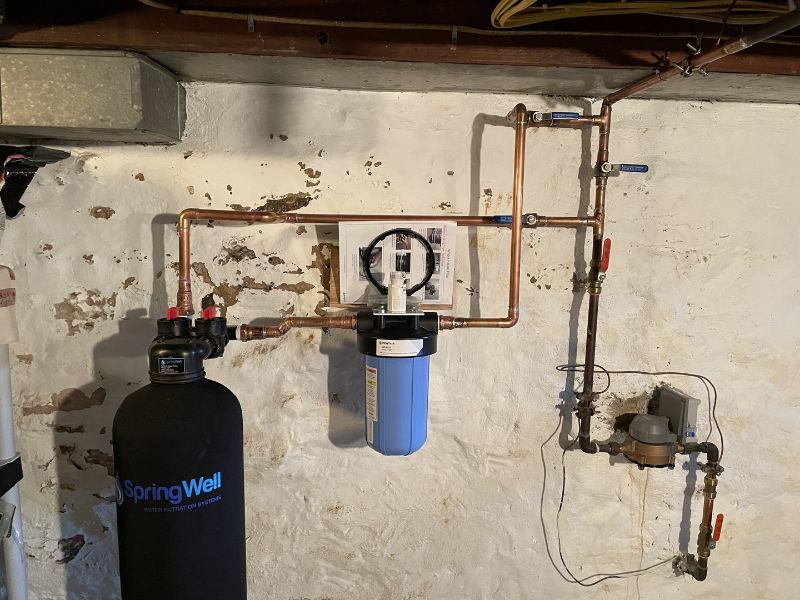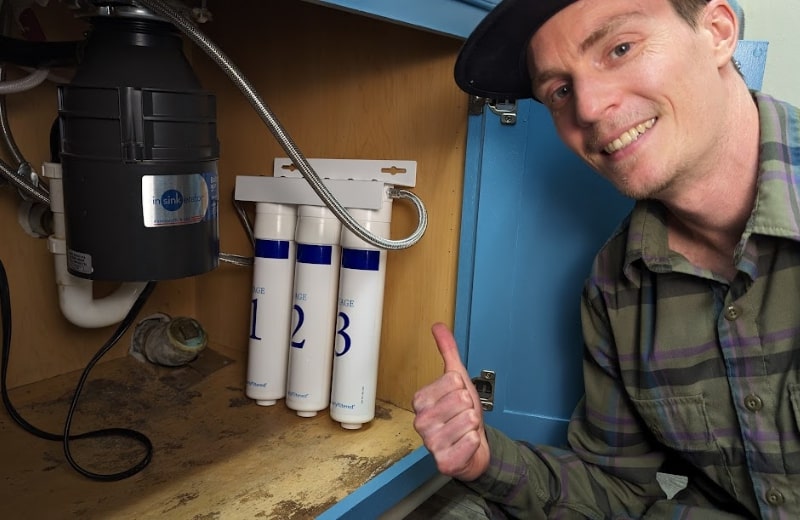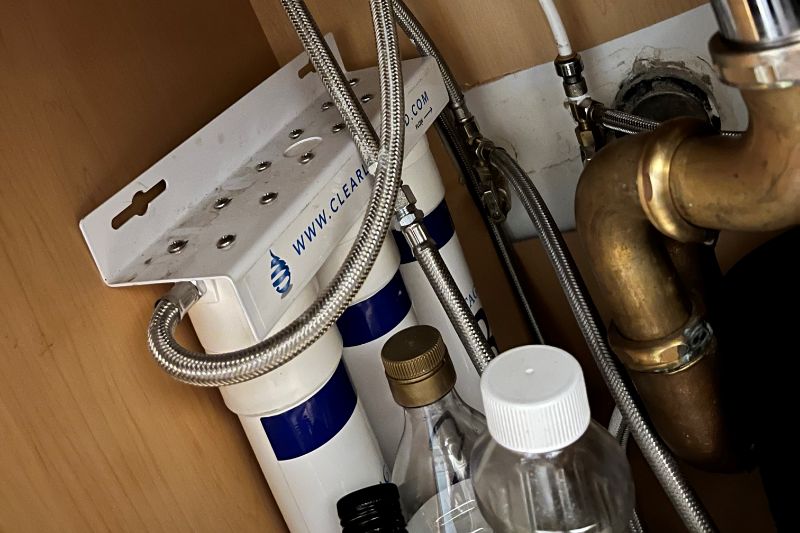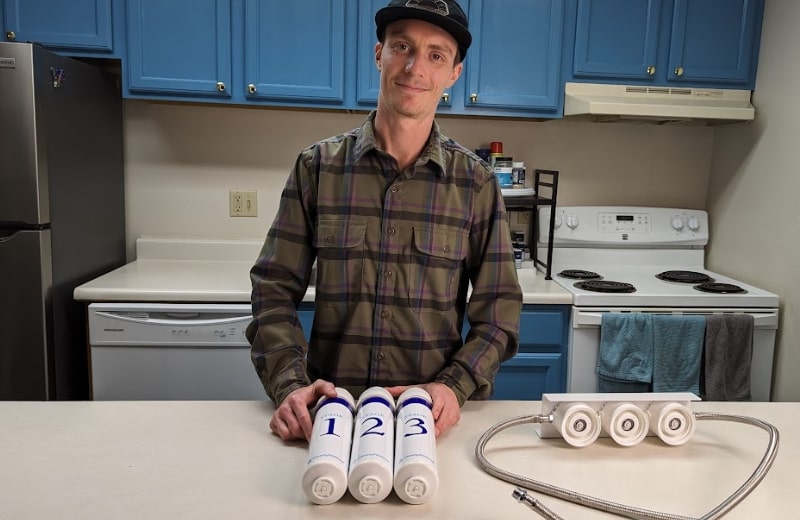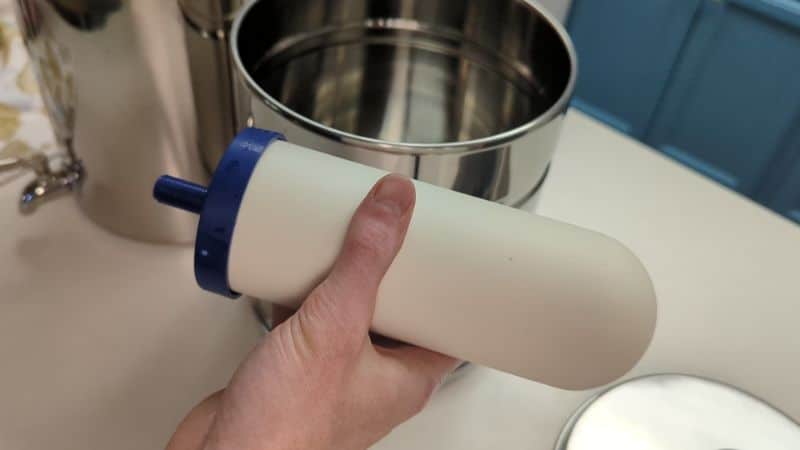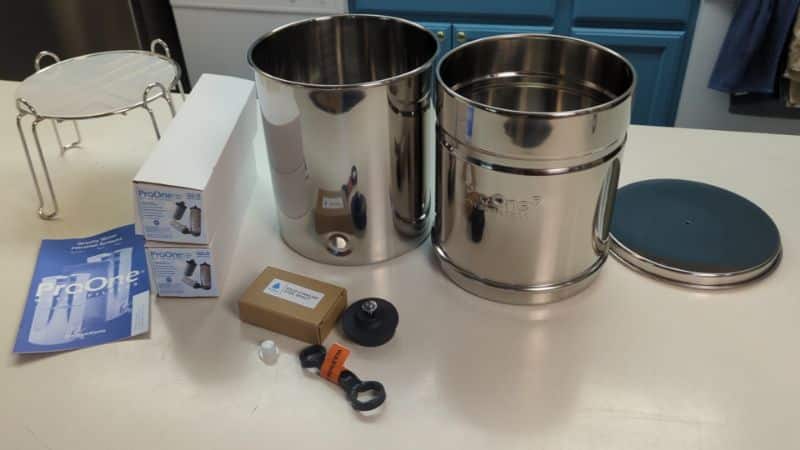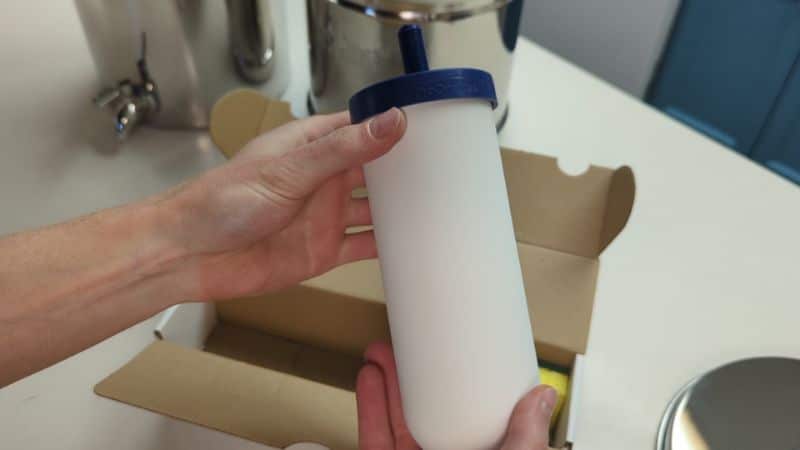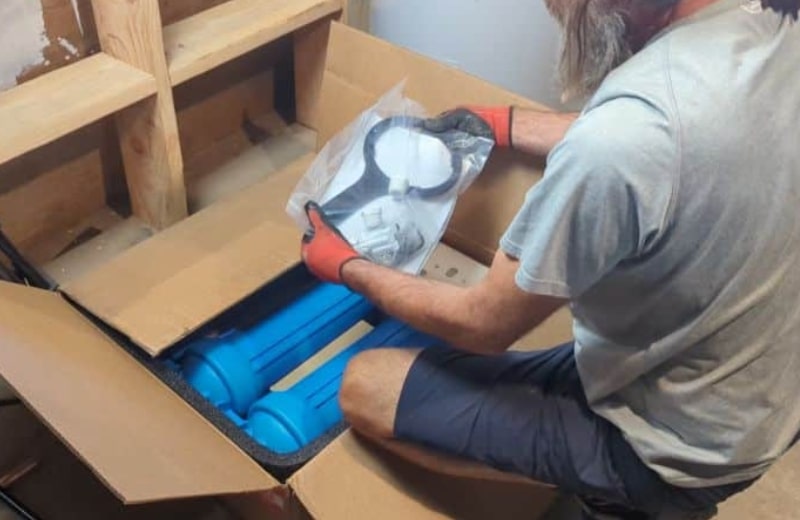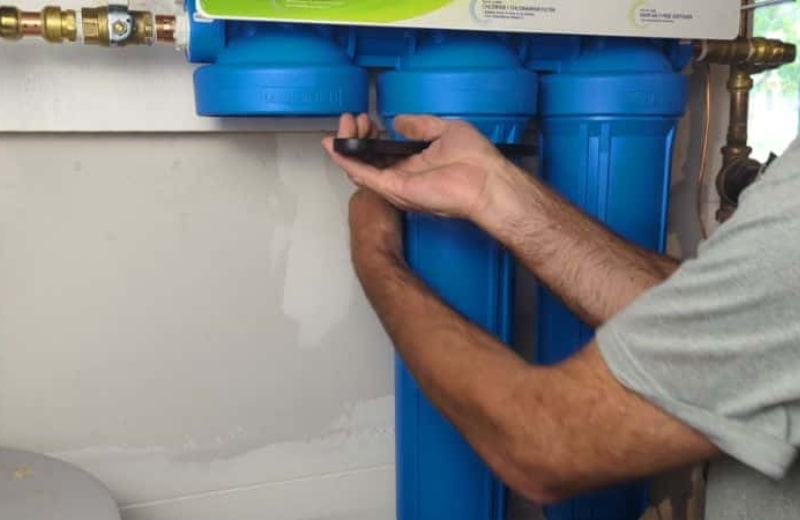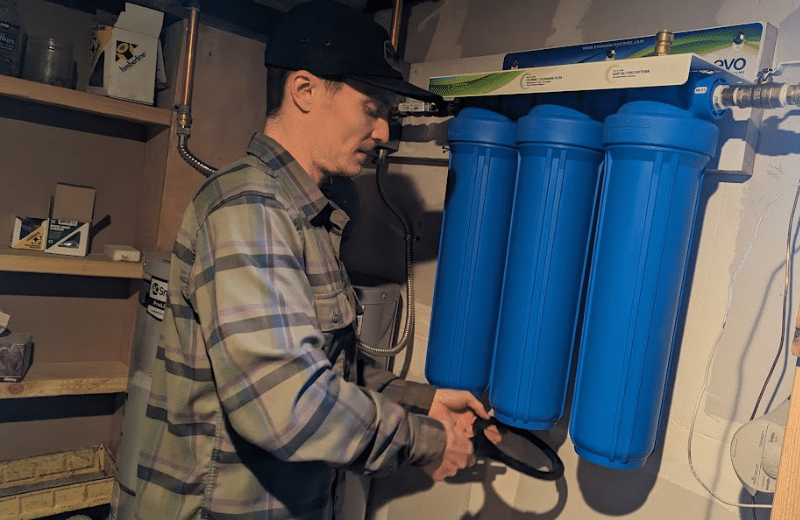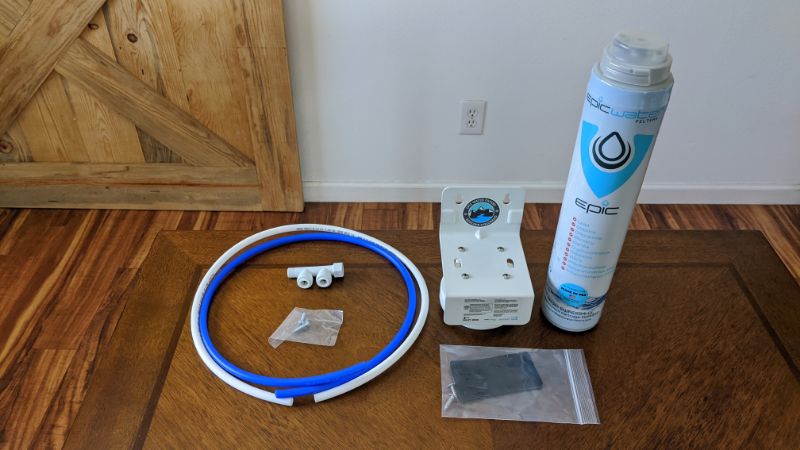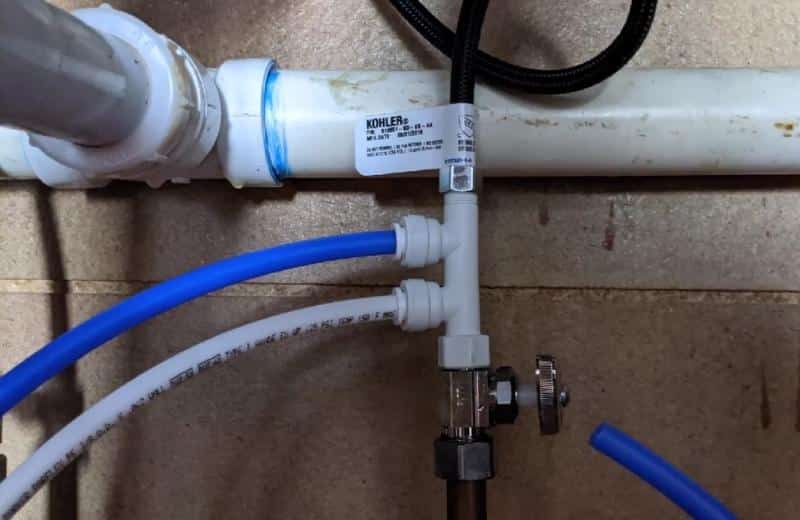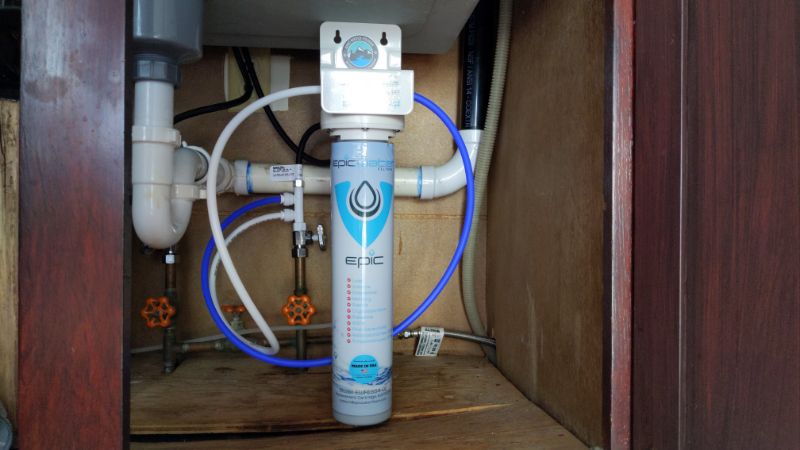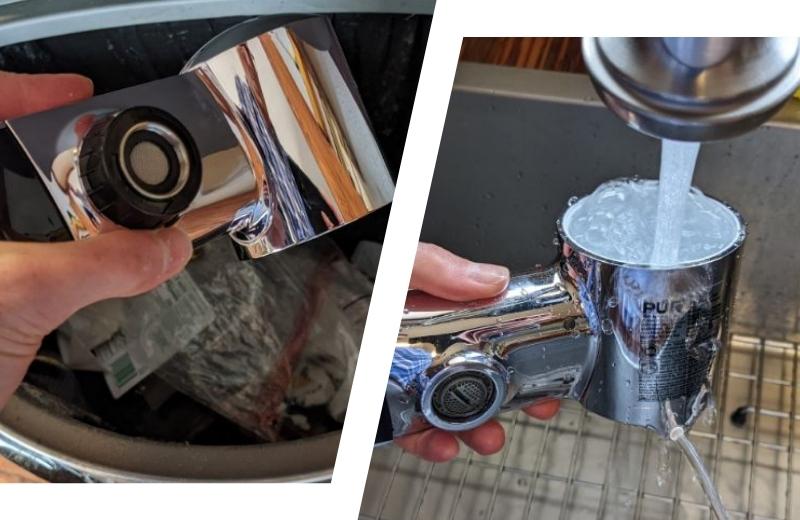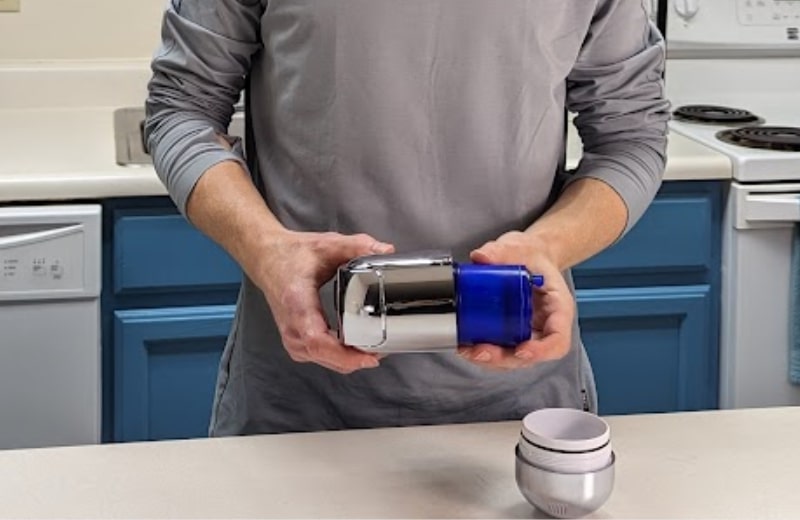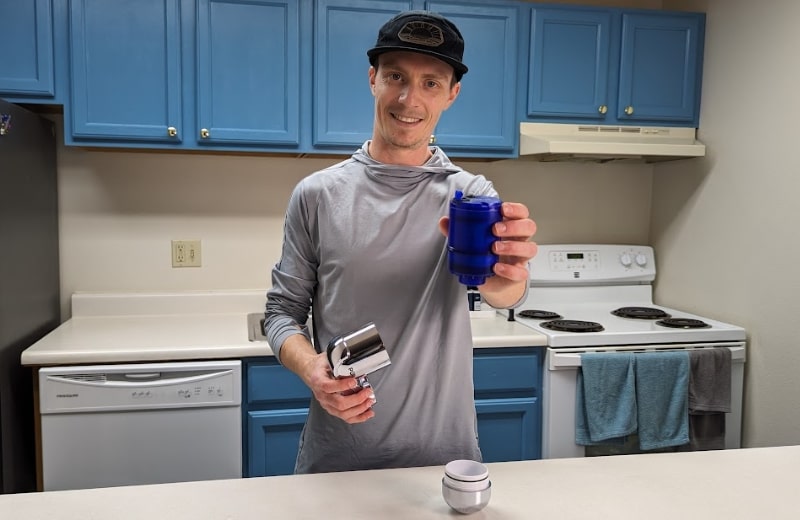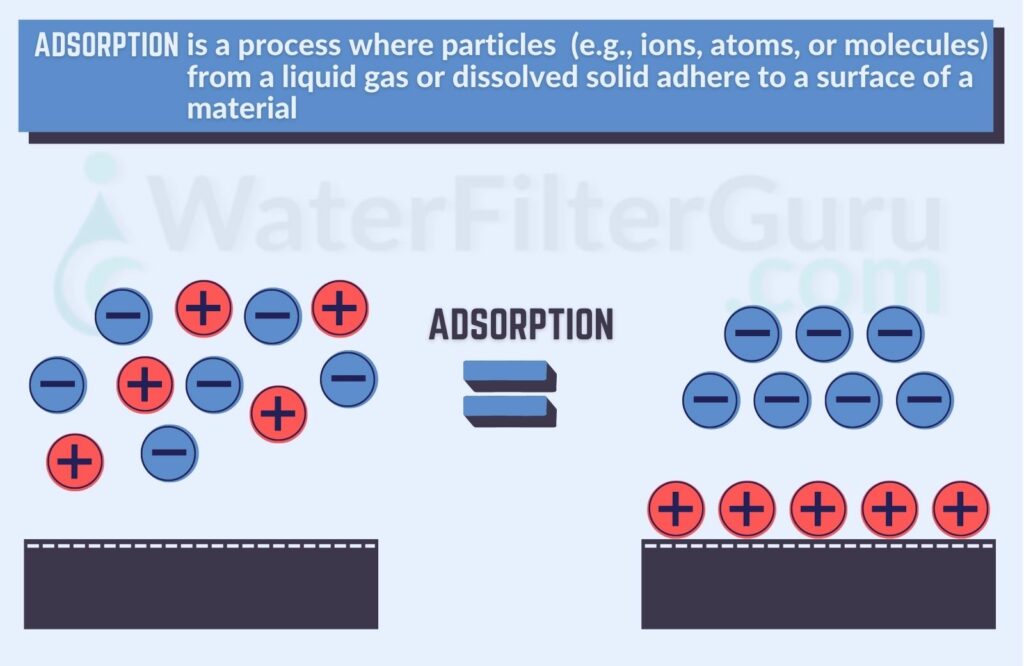These are our 6 top recommended activated carbon water filters in 2025. From whole house systems to simple pitcher filters, we’ve found a solution for everyone.
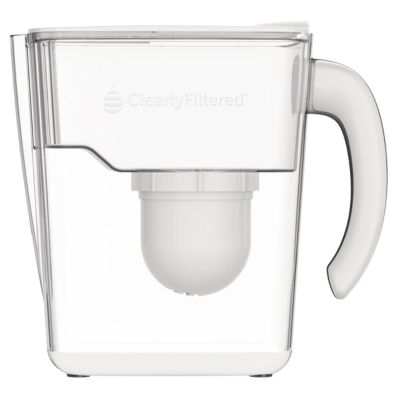
Clearly Filtered Water Pitcher
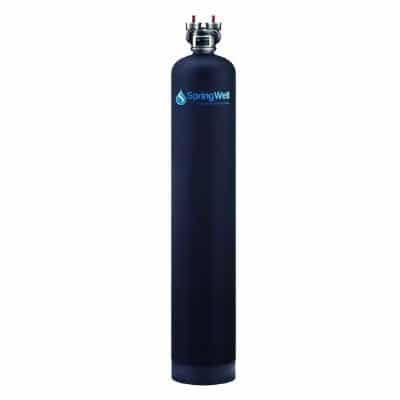
SpringWell CF Whole House Water Filter System
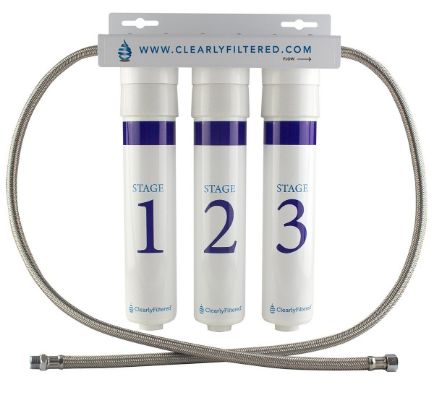
Clearly Filtered 3-Stage Under the Sink System
At WaterFilterGuru.com, we’re passionate about bringing you the purest, freshest water right from your tap. And when it comes to achieving that level of water quality, activated carbon filtration stands out as one of the most reliable, versatile, solutions. In fact, based on our own research, it’s the most commonly used filtration media for improving city water for aesthetic problems, with one study finding GAC filters capable of reducing total suspended solids down to 1-3 mg/L.
Activated carbon filters have long been regarded as the gold standard in water filtration, and for good reason. Their affordability and consistent ability to capture impurities, chemicals, and unpleasant tastes and odors makes them a standout choice for folks seeking top-tier water treatment without breaking the bank.
In this comprehensive guide, we’ve put our expertise to work to produce our shortlist of top-recommended activated carbon water filters for various situations and preferences. We’ve selected and ranked the products in this list based on our own experience researching, reviewing, and testing a selection of the most popular activated carbon filters available today.
Table of Contents
🥇 Best Activated Carbon Water Filters
- Our Pick & Best Budget Option: Clearly Filtered Water Pitcher
- Best Whole Home System: SpringWell CF Whole House Water Filter System
- Top Under-Sink Direct Connect: Clearly Filtered 3-Stage Under the Sink System
- Great Countertop System: ProOne Big+
- Runner Up Whole Home System: Kind E-1000 Whole House Water Filter
- Runner Up Under-Sink: Epic Smart Shield
- Best Faucet Filter: PUR PLUS Faucet Filtration System
📊 Comparison Chart of Activated Carbon Water Filters
| Product |  Clearly Filtered Pitcher |  SpringWell CF |  Clearly Filtered Under the Sink | 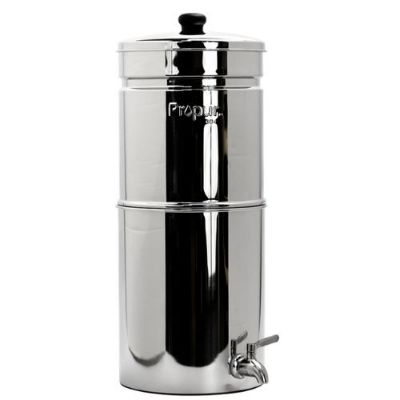 ProOne Big+ | 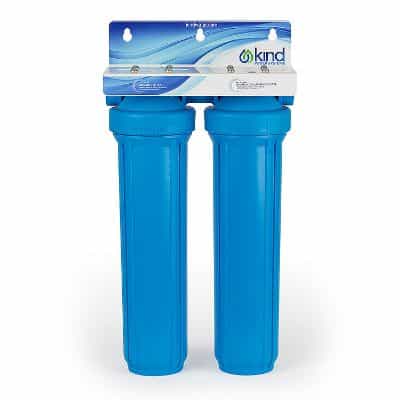 Kind E-1000 | 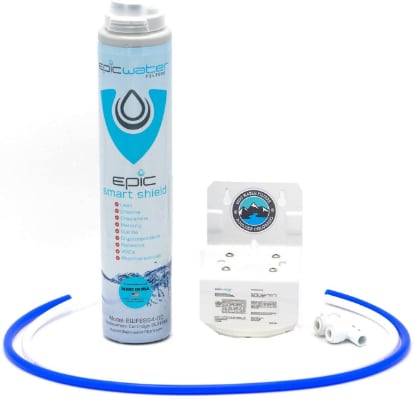 Epic Smart Shield | 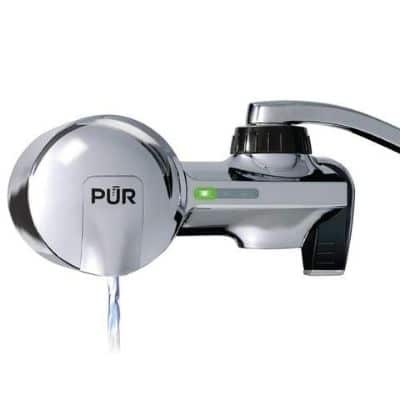 PUR PLUS Faucet Filtration System |
|---|---|---|---|---|---|---|---|
| Ranking | 1st | 2nd | 3rd | 4th | 5th | 6th | 7th |
| Ratings | 5/5 | 5/5 | 5/5 | 4.5/5 | 4.5/5 | 4.5/5 | 4.5/5 |
| Price | $90.00 | $1016.44+ | $550.00 | 229.95+ | $776.12 | $108 | $48.95+ |
| Contaminants Reduced | 365+ | 10+ | 232+ | 200+ | 150+ | 70+ | 70 |
| Certifications or Testing | NSF 42, 53, 401 & 473 | – | NSF 42, 53, 401 & 473 | NSF 42, 53, P231 | – | NSF 42, 53, 401 | NSF 42, 53, 401 |
| Process | Mechanical + Carbon + Ion Exchange | Catalytic Carbon + KDF | Mechanical + Carbon + Ion Exchange | Activated Carbon + Ceramic | Sediment + Coconut Shell Carbon | Mechanical + Carbon + Ion Exchange | Carbon + Ion Exchange |
| Filter Life | 100 gallons | 1,000,000 gallons | 2,000 gallons | 1,000 - 1,200 gallons | 80,000 gallons | 651 gallons | 100 gallons |
| Annual Cost | ~$140 | ~$40 | ~$200 | ~$100 | $120 – $300 | ~$120 | ~$100 |
| Warranty | Lifetime | Lifetime | Lifetime | 1 year | Lifetime (limited) | Lifetime | 2 years |
⭐ Reviews – Best Activated Carbon Filters 2025

Clearly Filtered Water Pitcher
In our opinion, the best activated carbon water filter of 2025 is the Clearly Filtered Water Pitcher. This WQA-certified filter is one of the most affordable carbon filters we tested, yet reduces more contaminants than any of its competitors, using a unique filtration process that combines activated carbon, a woven mesh screen, and a composite shell. We didn’t find a better-value carbon filter than this – reducing 365+ contaminants and costing just $90 upfront.
Specs
| Price | $90.00 |
| Contaminants Reduced | 365+ |
| Certifications or Testing | NSF 42, 53, 401 & 473 |
| Process | Mechanical + Carbon + Ion Exchange |
| Filter Life | 100 gallons |
| Annual Cost | ~$140 |
| Warranty | Lifetime |
We were able to test the Clearly Filtered pitcher on our city water in Steamboat Springs and Fort Collins, Colorado. We tested a few different carbon-based filter pitchers, but we had the best experience with this Clearly Filtered model, making it our top choice in terms of performance and value for money.
When it comes to pricing, it’s worth noting that the Clearly Filtered pitcher is pretty expensive compared to the average water filter pitcher price point. When we got it for testing, it had an upfront cost of $90, while most other pitchers we tested were within the $40-$60 range. Is the Clearly Filtered Water Pitcher worth the additional investment? In our eyes, absolutely – and that’s exactly why it secures the top spot on our list. The slightly higher price tag is justified by its impressive removal of 365 contaminants, surpassing any other carbon-based pitcher we’ve tested. For context, the average carbon filter-using water pitcher has only been tested to remove 5-10 contaminants.
We estimated we’d spend around $165 annually on filter replacements. We noted that selecting the Autoship option (which means signing up for automatic replacement filter shipments every 2, 3, 4, 5, or 6 months) reduces the initial pitcher price to $81 and applies a 10% discount to all replacement filters. Our filters lasted approximately 3.5 months – their listed capacity is up to 100 gallons.
| Bundles | Price |
|---|---|
| Pitcher Only | $90 |
| Pitcher + 3 Pack | $245 |
| Pitcher + 6 Pack | $395 |
Best For:
Folks looking for the very best activated carbon water filter system that can reduce more contaminants at a lower cost than its competitors.
What We Like:
- Tested to remove hundreds more contaminants than any other activated carbon filter
- WQA certified to remove select contaminants
- No-install, rental-friendly design
- Backed by a lifetime guarantee
What We Don’t Like:
- Costlier than other carbon-based water pitchers
- Must be manually refilled with water
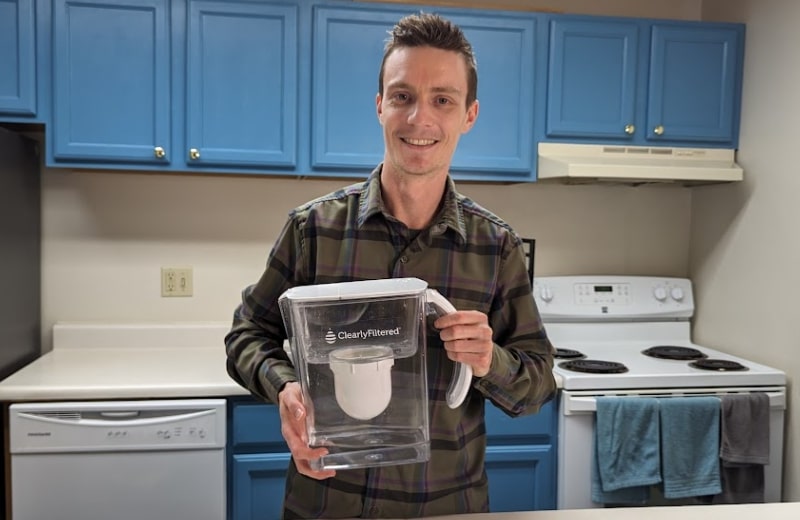
Three-Stage Combined Filter Media
The Clearly Filtered Water Filter Pitcher is a gravity-based filtration system that doesn’t need a waterline or electricity connection. We assembled the pitcher in a matter of minutes on our kitchen countertop. It’s pretty self-explanatory to use: we just filled the top water reservoir and waited for it to filter into the main pitcher reservoir below. The filter itself combines three types of filtration media: granular activated carbon, a woven mesh screen (which prevents large particles from clogging up the carbon media), and a composite shell (which increases water’s contact time with the filter). This blend of media is what makes the Clearly Filtered pitcher capable of removing 360+ contaminants – other water filter pitchers with more simple carbon filter designs can only reduce a fraction of contaminants in comparison.
Since performance certifications are becoming more and more commonplace amongst carbon filters, it was pretty essential to us that the Clearly Filtered pitcher ticked this box – and it does. The pitcher has recently secured a WQA certification to NSF/ANSI Standards 42 and 53, validating its effectiveness in reducing aesthetic contaminants like chlorine, taste, and odor, as well as PFOA/PFOS. We also appreciated having easy access to the manufacturer’s third-party test results, which list all the contaminants that the filter has been lab-tested to remove, including chlorine and chloramine (99.9%), lead (99.5%), nitrate and nitrite (>99.93%), VOCs (99.9%), and fluoride (>99.54%). While we haven’t yet conducted an independent test of our tap water for contaminants before and after using the pitcher, we have taste-tested our water. The filtered water tasted cleaner and crisper, without any lingering chlorine aftertaste.
Lightweight, Robust Design
Design quality is something we consider particularly carefully when it comes to water pitcher filters, especially since they’re predominantly constructed from plastic. We looked into Tritan—the plastic used in the Clearly Filtered pitcher—and learned that it’s one of the strongest and most impact-resistant plastics available today. Importantly, it’s both BPA- and BPS-free. The pitcher felt both lightweight and robust to hold, with an oversized handle that made it easy to grip even when it was full of water. The 80-ounce (or 10-cup) water holding capacity was convenient for our two-person household, requiring only 3-5 refills a day.
While the filtration process may be a bit slower, as is the case with all gravity-based water filters, we didn’t mind the extra wait. The intricacy of the pitcher’s filter design, combining proprietary filter media and granular activated carbon, means it offers a more comprehensive filtration process compared to standard carbon filters. We’d rather endure a slightly longer filtration time that gives us the assurance that the water is undergoing the most thorough filtration, removing as many contaminants as possible. But if you do want instant access to filtered water, you’re going to want to look elsewhere.
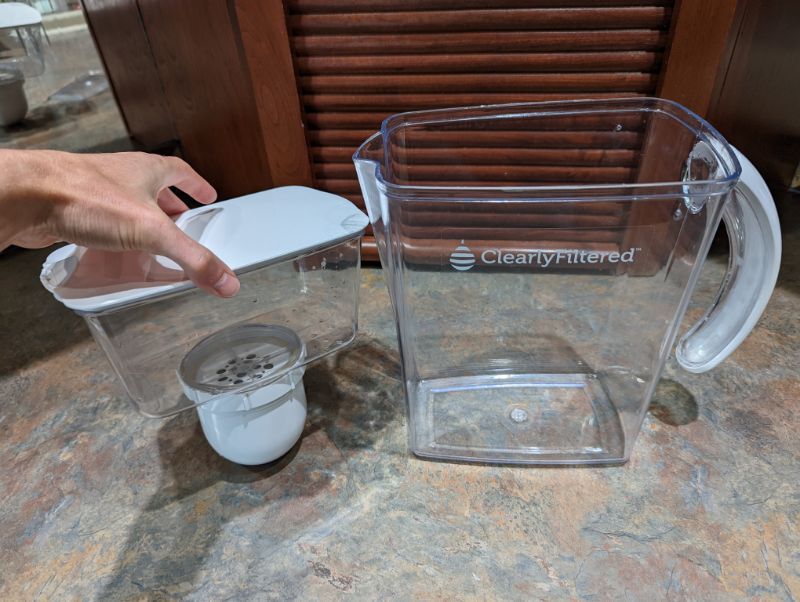
Read the full review: ClearlyFiltered Pitcher Review

SpringWell CF Whole House Water Filter System
Based on our testing, the best whole house filtration system that uses activated carbon filter media is the SpringWell CF Whole House Water Filter System. This filter uses KDF and catalytic carbon coconut shell filtration media to remove all the key concerning contaminants – including chlorine and chloramine – from an entire home’s plumbing supply. Plus, it comes with a few SpringWell-only perks, including an unbeatable limited lifetime warranty and a 6-month money-back guarantee.
Specs
| Price | $1016.44+ |
| Contaminants Removed | 10+ |
| Certifications or Testing | – |
| Process | Catalytic Carbon + KDF |
| Filter Life | 1,000,000 gallons |
| Annual Cost | ~$40 |
| Warranty | Lifetime |
| Upgrades | Price | Uses |
|---|---|---|
| UV Water Purification System | $1100.99 | Boil water advisory protection |
| Reverse Osmosis Water Filter System | $442.23 | Drinking water |
| Easy Installation Kit (Single Tank) | $157.49 | Clack connectors add-on |
We were able to put the SpringWell CF to the test in our own home, and straight away, there was one key differentiator between this system and most other carbon filters we tested: it’s a point-of-entry filtration solution. That meant we could treat our water right as it entered our home, before it had the chance to travel around our plumbing. The obvious advantage here is that it wasn’t only our drinking water that was contaminant-free – we could also shower in, supply our appliances with, and wash our hands and clothes in filtered water.
We anticipated a higher price for a whole-home system like the SpringWell CF, and the upfront starting price of $1,016 is likely out of some budgets. The good news is that the CF system doesn’t cost a lot to maintain because its carbon media has a 1-million-gallon capacity, so our only ongoing spend was replacing the sediment pre-filter every 6-9 months (costing less than $40/year). We went for the smallest CF1 1-3 bathroom system, which was plenty for our two-bathroom property. For larger households, the CF4 4-6 bathroom system is the next size up, at just under $1,200. The largest CF+ 7+ bathroom system, priced around $1,740, is the best option for commercial use.
| SpringWell CF Configurations | Price |
|---|---|
| CF1: 1-3 Bathrooms | $1016.44 |
| CF4: 4-6 Bathrooms | $1199.66 |
| CF+: 7+ Bathrooms | $1737.20 |
Best For:
Folks looking for the best-value activated carbon water filter that will protect their entire water supply, including their shower water, from common drinking water contaminants.
What We Like:
- Removes contaminants from water supplying all appliances and fixtures
- Catalytic carbon media targets chlorine, chloramine, and more
- Media lasts years without needing to be replaced
- Three system size options
What We Don’t Like:
- Difficult install
- Not performance certified
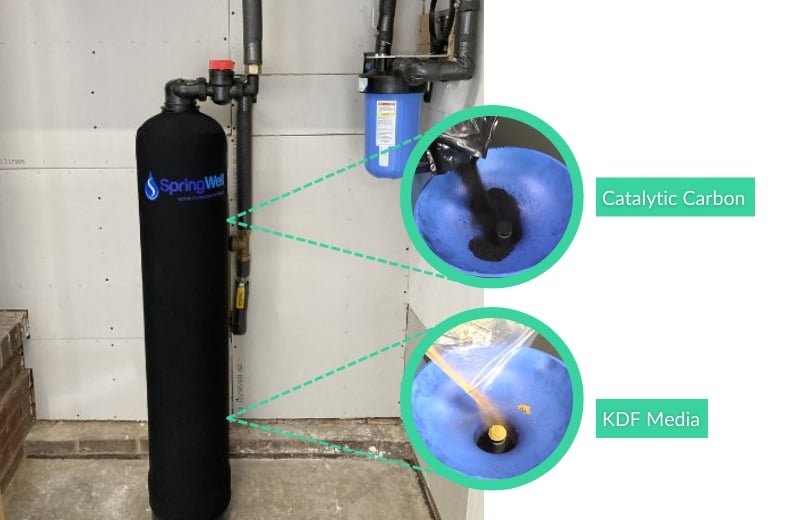
Comprehensive Whole-Home Water Treatment
As we mentioned, the SpringWell CF is a whole-home system, intended for installation at the main water line after entering your home. We checked the installation instructions, and they’re pretty easy to follow. That said, we opted to get our unit professionally installed by a plumber to avoid potential disruptions to our plumbing supply. Our advice is to factor in the extra cost of hiring an expert if you don’t have much plumbing experience.
For us, the primary advantage of the SpringWell CF was that it efficiently removed contaminants not only from our drinking water, but also from all the fixtures and appliances throughout our home. Our shower, bath, washing machine, dishwasher, and other appliances were all supplied with filtered water, so we got the assurance of knowing that the water we used for any purpose was clean and filtered. Because the unit removes chlorine and chloramine, we had the extra advantage of being able to avoid exposure to these disinfection chemicals through inhalation of vapor from our shower water.
Multi-Media Filtration for Extensive Contaminant Removal
The SpringWell CF is a tank-based system that’s loaded with a filtration media, rather than using filtration cartridges. It uses a modified version of activated carbon, known as catalytic carbon, which has additional contaminant-removal abilities – as well as removing chlorine, disinfection byproducts, and several heavy metals, it also targets chloramine and hydrogen sulfide.
Our only gripe with the CF model is that it doesn’t have an official performance certification. For this reason, it was our top priority to test the filter’s contaminant removal abilities on our own water supply in Arvada, Colorado, with a before-and-after water quality test. Our initial water supply contained trace concentrations of numerous concerning contaminants, including several types of disinfection byproducts and heavy metals.
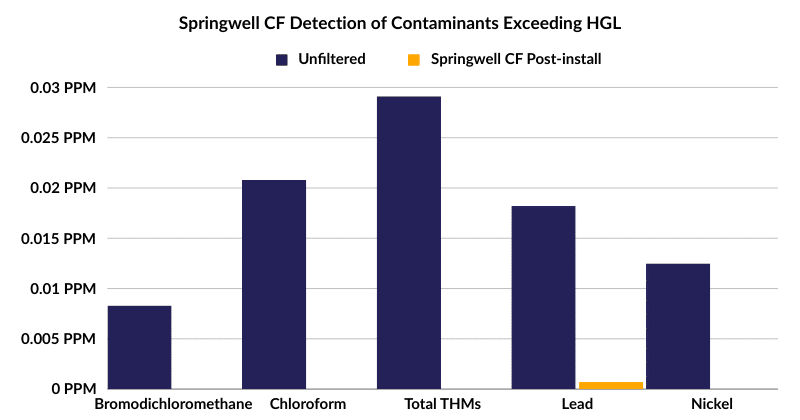
According to our post-filtration test results, the CF system removed 100% of three disinfection byproducts—bromodichloromethane, trihalomethane, and chloroform. It also removed 100% nickel, molybdenum, and cobalt, and significantly reduced lead and copper by 96% and 76%. It reduced fluoride by around 17% – this was pleasantly surprising to us as the unit isn’t advertised for fluoride removal. Plus, it also targeted the other heavy metals in our water, like strontium, zinc, barium, and manganese.
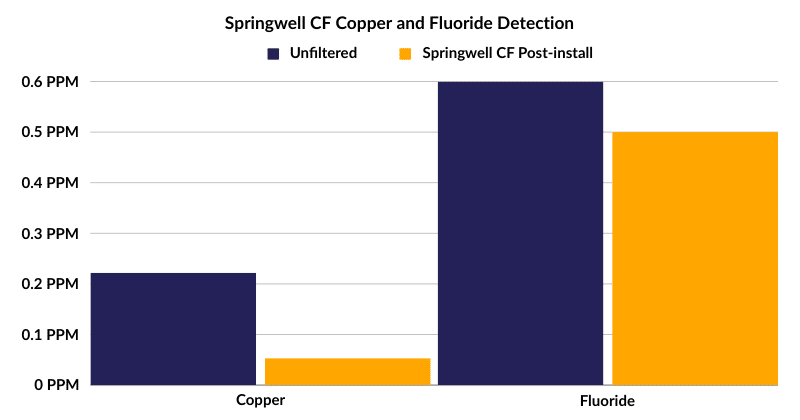
For a closer look at the SpringWell CF’s performance, refer to our 3rd-party laboratory results below.
| Contaminant | Measurement | Pre-Filtration | Post-Filtration | % Change |
|---|---|---|---|---|
| Barium | PPM | 0.0267 | 0.0158 | -41% |
| Bromodichloromethane | PPB | 0.00832 | 0 | -100% |
| Chloroform | PPB | 0.0208 | 0 | -100% |
| Cobalt | PPM | 0.0011 | 0 | -100% |
| Copper | PPM | 0.222 | 0.0532 | -76% |
| Fluoride | PPM | 0.6 | 0.5 | -17% |
| Lead | PPM | 0.0182 | 0.0007 | -96% |
| Manganese | PPM | 0.002 | 0.0013 | -35% |
| Molybdenum | PPM | 0.0016 | 0 | -100% |
| Nickel | PPM | 0.0125 | 0 | -100% |
| Strontium | PPM | 0.125 | 0.09 | -28% |
| Sulfate | PPM | 36 | 27.2 | -24% |
| Total THMs | PPB | 0.02912 | 0 | -100% |
| Zinc | PPM | 0.917 | 0.255 | -72% |
Read the full review: SpringWell Whole House City Water Filter System Review

Clearly Filtered 3-Stage Under the Sink System
We think that the Clearly Filtered 3-Stage Under the Sink System is the best under-sink water filtration system using carbon filter media available today. In our testing, Clearly Filtered once again beat out its competitors with its ability to remove more contaminants than any other under-sink system we’ve found, with testing to NSF Standards and an official WQA performance certification – and all for a competitive price of $550.
Specs
| Price | $550.00 |
| Contaminants Reduced | 232+ |
| Certifications or Testing | NSF 42, 53, 401 & 473 |
| Process | Mechanical + Carbon + Ion Exchange |
| Filter Life | 2,000 gallons |
| Annual Cost | ~$200 |
| Warranty | Lifetime |
Given our positive experience with the Clearly Filtered pitcher, we were keen to see how the manufacturer’s Under-Sink System performed, especially given that it’s advertised to remove 232+ contaminants while reducing water flow by just 20%. We handled the install ourselves, and it was a pretty simple job that took less than 30 minutes: we just connected it directly to the cold water line under our kitchen sink, using the provided flexible connectors. We didn’t have to drill a hole for a dedicated faucet, which we were pleased about.
At the time of our review, the upfront cost for this system was around $550. It came with three initial filters: the priming carbon filter, the heavy metals and VOC filter, and the fluoride filter. These filters are listed to last up to 2,000 gallons, or around 9-15 months, depending on your water usage. We got around 12 months out of the filters before they needed replacing, and our annual maintenance cost didn’t exceed $200.
Best For:
People who want to filter their kitchen tap water with an advanced, on-demand carbon-using filtration solution that’s tested to remove more contaminants than any other non-RO under-sink system.
What We Like
- Removes more contaminants than other carbon under-sink systems
- WQA certified and performance-backed by third-party testing to NSF Standards
- Easy to install & can be used with an existing faucet
- Long filter lifespan
What We Don’t Like
- Costs more than similar systems
- Requires more maintenance – 3 separate filters to replace

Thorough Three-Stage Under-Sink Filtration
The Clearly Filtered Under-Sink System combines an activated carbon filter (made from coconut shells – known in the industry to be the best material for carbon filtration) with a heavy metal & VOCs filter and a dedicated fluoride filter to provide thorough under-sink drinking water treatment. It has been third-party tested by EPA-accredited laboratories to reduce or eliminate over 232 contaminants, including up to 95.30% chloramine, 98.58% chlorine, 90.65% fluoride, 94.27% arsenic, 99.34% lead, as well as PFAS, pharmaceuticals, pesticides, and more. Recently, the system has obtained a performance certification by the Water Quality Association (WQA) to NSF/ANSI Standard 42, for the reduction of chlorine taste and odor. It also has a WQA certification to NSF/ANSI Standard 372, for lead-free construction.
We’re planning to conduct a before-and-after water quality test to see exactly what the system is capable of removing from our water, but in the meantime, we’ve assessed its impact on water flow and noted any visible improvements we detected in water quality and taste. Before installing the system, our under-sink water flow allowed us to fill a large glass in about 4 seconds. Post-installation, the filling time increased to around 8 seconds, indicating a reduction in water flow by about 50%. While this deviates from the manufacturer’s 20% claim, our initial water flow was very high to begin with, so we weren’t disappointed by the 50% decrease. As for taste, we noticed that our filtered water tasted cleaner, with no hint of chlorine, and had a smooth mouthfeel – exactly what we’d expected from a carbon filter that’s certified to improve water aesthetics.
Read the full review: Clearly Filtered Direct Connect Under-Sink System Review

ProOne Big+
Next on our list is the ProOne Big+ Gravity Water Filter, which is, in our opinion, a superior countertop water filter that uses activated carbon ceramic filtration media. We love this filter because of its durable, stainless steel design and its ability to remove more than 200 contaminants – including fluoride, bacteria, and lead – and has third-party testing to prove its performance.
Specs
| Price | 229.95+ |
| Contaminants Removed | 200+ |
| Certifications or Testing | NSF 42, 53, P231 |
| Process | Activated Carbon + Ceramic |
| Filter Life | 1,000 – 1,200 gallons |
| Annual Cost | ~$100 |
| Warranty | 1 year |
Like the Clearly Filtered Pitcher, the ProOne Big+ is a gravity filtration system. Both units have the same straightforward design, with an upper unfiltered water reservoir and a lower filtered water chamber. Out of the box, the obvious difference is that the Big+ has a much larger water-holding capacity (3 gallons versus the CF pitcher’s 10 cups). Our filter unit came with all the parts we needed for setup, including a stainless steel spigot. It’s quite a tall unit, which restricted where we could assemble it in our kitchen – it was too tall to sit under our kitchen wall units. But it doesn’t need to hook up to a water supply or power outlet, which opened up our options.
We opted for the Big+ configuration with two filters in the polished finish, priced at $290. We’ve tested a few other stainless steel countertop units, including the Big Berkey, and the Big+ is significantly cheaper, while offering essentially the same performance. Filters are rated to last 9-18 months depending on your water usage and quality, and the number of filters you use. We opted for two filters (you can choose up to three, depending on how much water you want to filter at once), and we expected to spend less than $100 on filter changes.
Best For:
Anyone looking for the very best no-install countertop carbon filtration system that removes 200+ contaminants and holds bigger batches of water than a filter pitcher.
What We Like
- Third-party tested to remove 200+ contaminants
- Treats both potable and non-potable sources
- Easy to assemble & doesn’t require electricity
- Long filter life
What We Don’t Like
- Big and bulky
- Not an instant filtered water solution
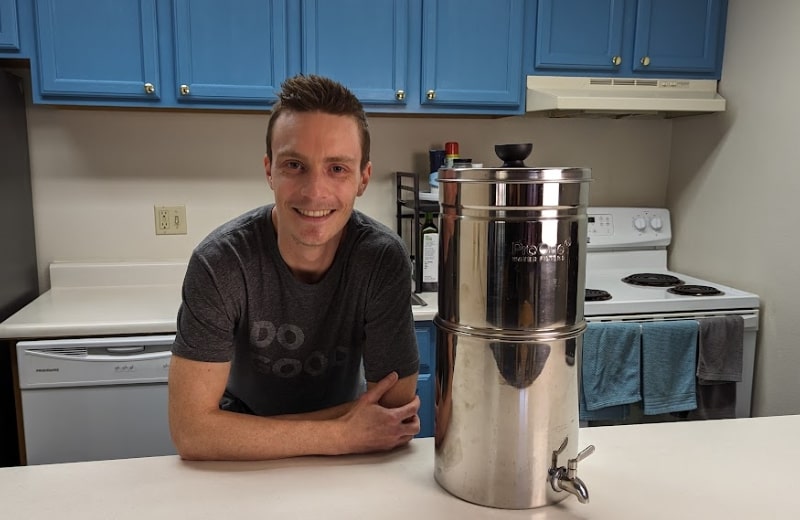
Independently Tested to Reduce 200+ Contaminants
The ProOne Big+ uses the manufacturer’s G2.0 filters, which contain activated carbon filter media in a ceramic shell. The filters have been independently tested to reduce or remove contaminants like fluoride, chlorine, bacteria, heavy metals (including arsenic and lead), pharmaceutical drugs, and pesticides, in line with NSF Standards 42, 53, P231, P401, and P473 (read the datasheet here). It’s one of the only carbon-based filters we’ve ever reviewed that can treat both potable and non-potable water sources, so we were keen to see what it could remove from our city water and local river water in Steamboat Springs, CO.
We used a third-party laboratory to test our before-and-after water quality. The G2.0 carbon ceramic filters excelled in some areas, removing 100% of lead, copper, aluminum, manganese, and fluoride.
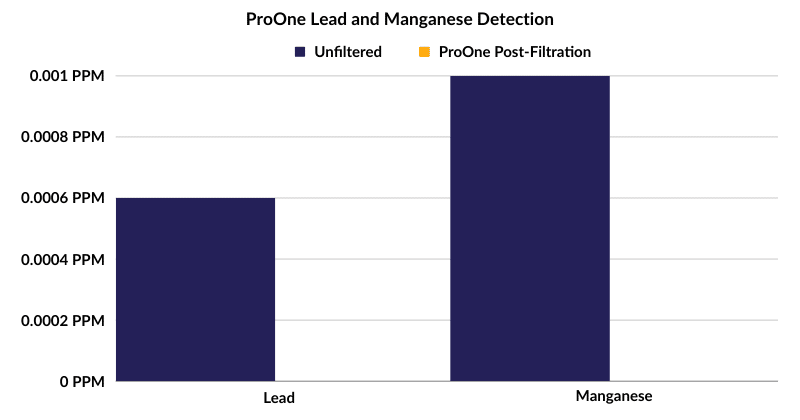
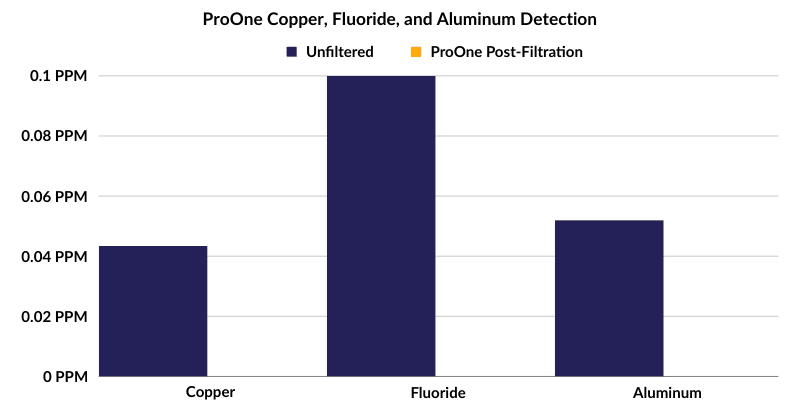
We were really pleased to see this result for fluoride removal given that many similar countertop systems we’ve tested require a separate filter for addressing this mineral. The filters were less effective at removing the two disinfection byproducts in our water, THMs and chloroform, with an average reduction of around 50%. In our river water test, the filters removed 100% of three types of bacteria, including E. Coli, which was exactly what we expected to see given its third-party testing for bacteria removal.
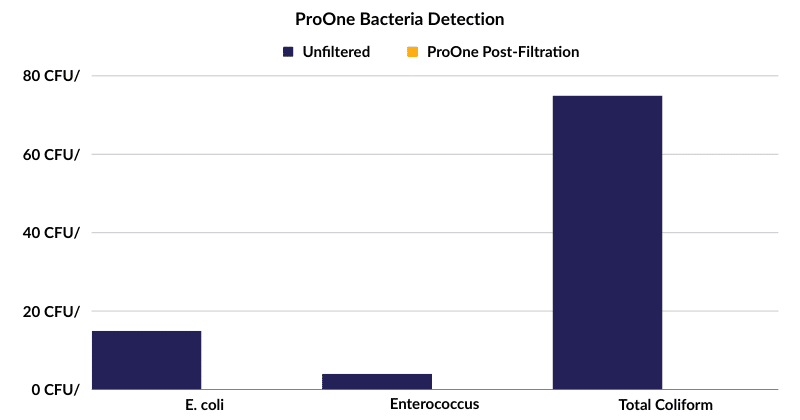
Our only disappointment was that the filters aren’t officially performance certified, despite the manufacturer’s slightly misleading claims that they carry an NSF 42 certification (this is for design only and not for contaminant removal).
Explore the third-party laboratory analysis of the ProOne Big+ in the table provided below.
| Contaminant | Measurement | Priming Water | Test 1 Pre-Filtration | Test 1 Post-Filtration | % Reduction | Test 2 Pre-Filtration | Test 2 Post-Filtration | % Reduction |
|---|---|---|---|---|---|---|---|---|
| Aluminum | PPM | ND | 0.052 | 0 | -100.00% | 0.03 | 0 | -100.00% |
| Barium | PPM | 0.0265 | 0.0127 | 0.0275 | 116.54% | ND | ND | ND |
| Bromodichloromethane | PPB | 0.00289 | 0 | 0.00319 | n/a | ND | ND | ND |
| Calcium | PPM | 35.1 | 8.8 | 19.3 | 119.32% | ND | ND | ND |
| Chloride | PPM | 14.4 | 6.9 | 8.3 | 20.29% | ND | ND | ND |
| Chloroform | PPB | 0.0141 | 0.0352 | 0.0155 | -55.97% | ND | ND | ND |
| Cobalt | PPM | 0.0013 | ND | ND | ND | ND | ND | ND |
| Copper | PPM | 0.0424 | 0.0434 | 0 | -100.00% | ND | ND | ND |
| E. coli | CFU/100ml | ND | ND | ND | ND | 15 | 0 | -100.00% |
| Enterococcus | CFU/100ml | ND | ND | ND | ND | 4 | 0 | -100.00% |
| Fluoride | PPM | 0.1 | 0.1 | 0 | -100.00% | ND | ND | ND |
| Iron | PPM | ND | ND | ND | ND | 0.1 | 0.02 | -80.00% |
| Lead | PPM | 0.0009 | 0.0006 | 0 | -100.00% | ND | ND | ND |
| Magnesium | PPM | 10.6 | 2.19 | 7.91 | 261.19% | ND | ND | ND |
| Manganese | PPM | ND | 0.001 | 0 | -100.00% | 0.02 | 0 | -100.00% |
| Phosphorus | PPM | ND | ND | ND | ND | 0.01 | 0.21 | 2000.00% |
| Potassium | PPM | 1.91 | 0 | 1.27 | n/a | ND | ND | ND |
| Sodium | PPM | 12.5 | 10.4 | 14.2 | 36.54% | ND | ND | ND |
| Strontium | PPM | 0.193 | 0.062 | 0.098 | 58.06% | ND | ND | ND |
| Sulfate | PPM | 24.1 | 10 | 16.9 | 69.00% | 42.29 | 27.4 | -35.21% |
| Total Coliform | CFU/100ml | ND | ND | ND | ND | 75 | 0 | -100.00% |
| Total THMs | PPB | 0.01699 | 0.0352 | 0.01869 | -46.90% | ND | ND | ND |
Gradual Access to Filtered Water
While the ProOne Big+ excels in its contaminant removal abilities, we were expecting that the filtration would take place at a slower pace. Unlike with the water filter pitchers we tested, we had more control over our filtered water production with the Big+. The more filters we used, the more water could be filtered at once. In our configuration with two 7-inch G2.0 filters, our water flow averaged around 0.5 gallons per hour. This isn’t super speedy, but we got into a good routine, filling the top chamber in the morning and at intervals throughout the day based on our water usage. That meant we always had a steady supply of filtered water when we needed it.
| ProOne Big+ Options | Price (Polished) | Price (Brushed) |
|---|---|---|
| 1 G2.07 Filter Element | $229.95 | $239.95 |
| 2 G2.07 Filter Element | $289.95 | $299.95 |
| 3 G2.09 Filter Element | $369.95 | $379.95 |
Read the full review: Full ProOne Big Plus Review

Kind E-1000 Whole House Water Filter
We found that the Kind E-1000 Whole House Water Filter is the second-most capable whole house water filtration system that uses carbon media. This 2-stage 15 GPM system is cartridge-based, meaning that it uses several cartridge filters (including a carbon filter cartridge) rather than carbon media, to reduce tens of contaminants in a whole home water supply.
Specs
| Price | $776.12 |
| Contaminants Removed | 150+ |
| Certifications or Testing | – |
| Process | Sediment + Coconut Shell Carbon |
| Filter Life | 80,000 gallons |
| Annual Cost | $120 – $300 |
| Warranty | Lifetime (limited) |
We tested the Kind E-3000, which is exactly the same as the Kind E-1000 but has an additional filter cartridge for conditioning water. For the sake of this review, we’ll focus only on the system’s contaminant removal abilities – as you’d find in the E-1000. The obvious difference between this unit and the SpringWell CF is that the E-1000 uses filter cartridges rather than media loaded in a tank. We found that the unit was shorter but wider than the CF model, and replacing the filter cartridges was much easier than emptying the media out of a tank. However, the filters needed replacing more often.
When we reviewed the E-1000, it was priced at around $730. (Keep an eye out for Kind Water Systems’ regular deals; they tend to offer some decent savings.) Our annual estimated spend on filter changes hovers around $150, assuming we’ll need to replace both cartridges once a year. It’s not as budget-friendly as the SpringWell CF in the long term, but it’s a trade-off for the easier install and lower upfront cost.
Best For:
Folks who like the idea of a whole home carbon water filter system but want to spend a bit less upfront and don’t mind replacing filter cartridges once a year.
What We Like
- More affordable upfront than the SpringWell system
- Filters the water in your whole home
- Fast 15 GPM flow rate
- Capable contaminant removal
What We Don’t Like
- No performance certification
- Needs annual filter cartridge replacements
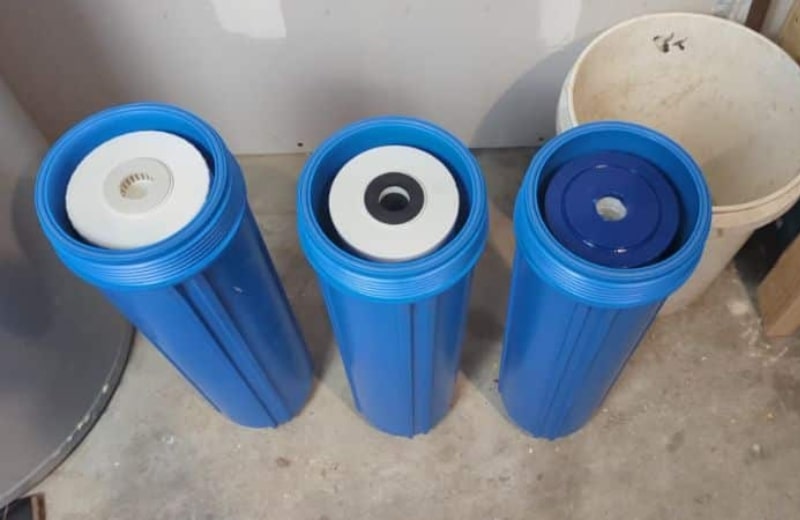
Targets Chlorine, Chloramine, & More with Catalytic Carbon Filtration
We were able to install and test the E-1000 Whole House Water Filter on our own whole-house water supply in Steamboat Springs, CO. The unit combines carbon filtration with a washable sediment filter to remove tens of contaminants, including chlorine, PFAS, lead, pesticides, and disinfection byproducts.
Just like the SpringWell CF system, the E-1000 uses the upgraded version of activated carbon: catalytic carbon filter media. This media is capable of removing additional contaminants, including chloramine and hydrogen sulfide. We appreciated that the carbon cartridge uses a solid carbon block filter, so it didn’t leak any black carbon dust into our water. Plus, carbon block media has a larger surface area that allows for a longer water contact time during filtration, facilitating more thorough contaminant removal. The sediment pre-filter didn’t seem to make much difference to our municipal water, but we assume it played an important role in extending the lifespan of the carbon filter.
We haven’t yet been able to do a direct comparison of our unfiltered versus filtered water for contaminants, but we noticed an improvement in our water quality, clarity, and taste post-installation. As with the SpringWell model, we had a consistent supply of high-quality water across all our fixtures and appliances, rather than from just a single drinking faucet. The E-1000 lacks a performance certification, but the manufacturer has at least provided a datasheet outlining the contaminants the carbon filter aims to address. Still, we’d prefer to see an official performance certification, or at least proof of third-party testing.
Whole-Home Cartridge-Based Filtration
As we mentioned, The Kind E-1000 is installed at the point of entry into your home, so water undergoes treatment before it circulates through your plumbing system. After reviewing the user manual, we opted to install the unit ourselves. The process took just under an hour and was easier in general – there were just two connection points (the inlet and outlet), which is why we decided to skip the professional installation in this case.
Cartridge-based whole-house filter systems sometimes struggle with flow, and the repercussions of an undersized system are worse – the last thing we wanted was to impact our overall water pressure. The Kind E-1000 exceeded our expectations, with a very high 15 GPM flow rate, surpassing many tank-based systems. It’s intended for households with up to 6 people, and we didn’t notice any interruptions to our water flow or pressure in our two-bathroom property.
Read the full review: Kind E-1000 Whole Home Municipal Water Filter Review

Epic Smart Shield
The Epic Smart Shield is our runner-up under-sink carbon filtration unit, coming second place to the Clearly Filtered under-sink system. We love this Epic system for its ability to remove 99.99% of 70 different tap water contaminants with activated coconut carbon block filter media. While it’s not quite as capable as the Clearly Filtered unit, it has something that the CF system doesn’t: an official IAPMO certification for its performance.
Specs
| Price | $108 |
| Contaminants Removed | 70+ |
| Certifications or Testing | NSF 42, 53, 401 |
| Process | Mechanical + Carbon + Ion Exchange |
| Filter Life | 651 gallons |
| Annual Cost | ~$120 |
| Warranty | Lifetime |
The Epic Smart Shield’s main attraction for us was its simplicity as a single-cartridge filtration system. Having just one filter cartridge means we’d have an easier job when it came to the install and maintenance, and we didn’t have to splash out hundreds of dollars upfront. The unit is smaller and more compact than the Clearly Filtered system, and we installed it vertically under our sink, without giving up too much storage space. We hooked it up to our waterline, meaning we had the convenience of filtered water right from our faucet.
Around the time of our review, the Smart Shield cost about $135. We could further reduce the cost to around $108 and get a 20% discount on all replacement filters (scheduled every 12, 16, 18, or 24 months) by signing up for Epic’s Clean Water Club. There was only one filter for us to change every 12+ months, but replacement filters are quite expensive at around $105 each.
Best For:
Anyone who wants the convenience of filtered water on demand but doesn’t want to spend hundreds of dollars on an under-sink carbon filtration unit.
What We Like:
- Good for smaller budgets
- Filters water on demand
- Officially IAPMO certified to remove 70+ contaminants
- Easy maintenance with just 1 filter to replace
What We Don’t Like:
- Needs to be installed under a kitchen sink
- Replacement filters are quite expensive
IAPMO Certified Under-Sink Carbon Filtration
The Epic Smart Shield uses a single filter cartridge, made from 100% recyclable activated coconut carbon, which traps impurities using adsorption. Like the Kind E-1000 Whole House system, the Smart Shield’s filter is made from solid carbon block, eliminating the common issue of black specks in the filtered water, as we’ve experienced with granular carbon filters.
The unit is one of the only under-sink carbon systems we’ve tested with a performance certification to three different NSF Standards by IAPMO: NSF Standard 42, for the removal of chlorine and chloramine, taste, odor, and Particulate Class I; NSF Standard 53, for the removal of contaminants with health effects (including lead, VOCs, mercury, asbestos, and cysts), and NSF Standard 401, for the reduction of pharmaceuticals and BPA. Datasheets for the Smart Shield can be reviewed here and here.
As an under-sink system, the Epic Smart Shield gave us the benefit of filtered water from our faucet without the complexity of a point-of-entry system installation. Like the Clearly Filtered system, it came with all the parts needed for a DIY install, and we hooked it up to our under-sink cold water line in just 25 minutes.
Once we’d installed the system, we noticed that the carbon filter did its job of removing poor tastes and odors from our water. In terms of flow rate, the system delivers around 1.25 gallons per minute (GPM). Before installing the filter, we were able to fill a glass in just under 4 seconds, and after, it took us slightly more than 6 seconds. We noticed that the flow rate continued to decrease as we used the system, so we think the 1.25 GPM rated flow is a little generous.
Read the full review: Epic Smart Shield Direct Connect Under Sink Filter Review

PUR PLUS Faucet Filtration System
Of all the carbon-based faucet water filters we’ve tried, the PUR PLUS Faucet Filtration System is by far the best. This easy-install water filter removed more than 70 contaminants from our kitchen faucet water, and we felt super reassured thanks to the filter’s three official NSF certifications for its performance.
Specs
| Price | $48.95+ |
| Contaminants Removed | 70 |
| Certifications or Testing | NSF 42, 53, 401 |
| Process | Carbon + Ion Exchange |
| Filter Life | 100 gallons |
| Annual Cost | ~$100 |
| Warranty | 2 years |
After water filter pitchers, faucet filters are our second personal favorites for simplicity of design and ease of use. But, just like many carbon-based pitcher filters, most of the faucet filters we came across in our research were just too basic – many could only remove 5-10 contaminants. The PUR Plus Faucet Filtration System is hands-down the best faucet filter we’ve ever tested for contaminant removal, combining activated carbon and ion exchange media to remove 70+ impurities.
Faucet filters are a cheap and cheerful filtration option, often at the expense of design quality and performance capabilities. The PUR Plus system is one of the most affordable choices on this list – when we reviewed the horizontal model, it was priced at just $48.95. But, unlike many similar systems, we didn’t have to compromise on quality. The unit removes tens more contaminants than its closest competitors, with an NSF certification to prove it. Filters need changing every 3 months or so, at an estimated cost of $100 per year.
Best For:
Anyone looking for an NSF certified carbon filter that they can attach to the end of their faucet for filtered water on demand.
What We Like:
- Removes more contaminants than all other faucet filters we’ve tested
- NSF and WQA certified performance
- DIY-friendly install
- Easy to use and maintain
What We Don’t Like:
- Filters don’t last long
- Only compatible with conventional faucets
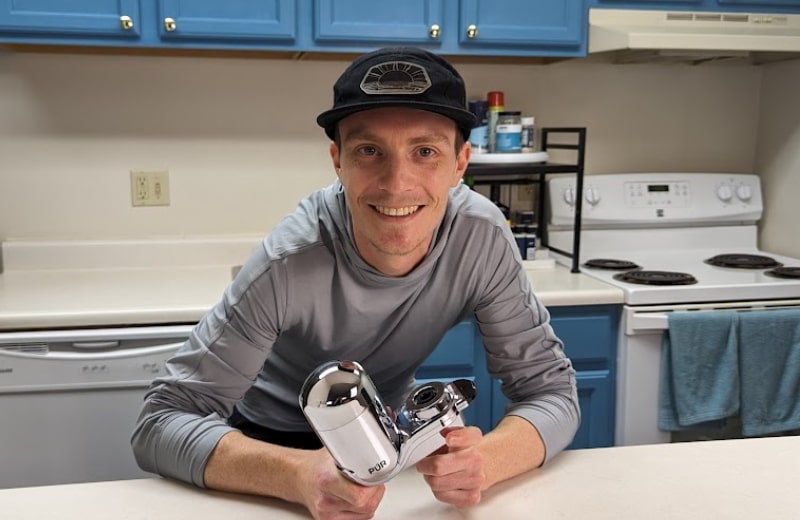
On-Demand Faucet Filtration
We know that for many folks, being able to access filtered water straight from the kitchen faucet is a must. But that doesn’t mean that we’d have to resort to the trickier install of an under-sink system – the PUR Plus Faucet Filter simply attached to the end of our faucet, with no need to cut into our water line. The only thing to keep in mind is that it’s not guaranteed to be compatible with all faucets. While several adapters were included in our box, that doesn’t mean the PUR Plus unit is a universal fit. If you have a pull-out faucet, a sprayer-style faucet, or any other modern, non-conventional faucet design, you’ll have to rule this filter out.
The PUR Plus filter has the benefit of a triple certification: it’s WQA and NSF performance certified to Standards 42, 53, and 401 (for the removal of chlorine and other aesthetic contaminants, health-concerning contaminants, and emerging contaminants/incidental compounds). Some of the contaminants it’s certified to remove include lead, chlorine, disinfection byproducts, pesticides, other heavy metals, VOCs, and microplastics. We noticed an improvement in our tap water taste, and while our flow rate did reduce post-install, we were still able to fill a large glass in less than 10 seconds.
Read the Full Review: PUR Faucet Filter Review
📚 Methodology: How We Tested The Best Activated Carbon Water Filters
When deciding on the shortlisted activated carbon filters in this guide, we listed all of the most important considerations for us to make in order to assess their overall value for money. These considerations were:
- Type of carbon media – First, we wanted to consider all the different types of carbon media that we might find in a water filtration system. We knew already that activated carbon could remove contaminants using a process called adsorption, pulling them out of the water, but that not all offered an identical performance. We identified three common types of carbon media: activated carbon block, granular activated carbon (GAC), and catalytic carbon. While they all perform similarly, GAC filters have a larger surface area (and therefore an enhanced contaminant removal ability) compared to carbon block filters, and catalytic carbon filters have the leading advantage over the other two filters because they’re also capable of chloramine removal. We’ve written a full guide on activated carbon media, which you can check out for more information about these filter types.
- Additional filtration media/stages – We’ve tested several filters in the past that use activated carbon alone as a treatment method. This limits them, performance-wise, meaning they can only usually remove a handful of contaminants. We prioritized the carbon filters that combined this media with other types of filtration media, like ion exchange, activated alumina, KDF, and ceramic media, giving them the ability to remove tens or hundreds more contaminants.
- Contaminants removed – Speaking of contaminant removal, we were pleased to see that the competition was tough across all categories of carbon filters we tested. We didn’t want to risk being exposed to any contaminant with possible health effects in our water, so our priority was to remove as many contaminants as possible. Some of the best carbon filters we shortlisted have been tested to remove more than 200, even 300, impurities. If you don’t know what your water contains, get it tested.
- Filter type – We found carbon filters used in a variety of filtration systems across different categories, including under-sink systems, countertop gravity units, whole-home systems, faucet filters, and water bottle filters. We tested as broadly as possible, knowing that some folks would prefer certain filter types over others. In a couple of categories, like countertop gravity filters and under-sink systems, we ended up recommending multiple different filters, since they each offered different benefits for different situations.
- Testing/certifications – We personally feel the most reassured of a filter’s performance if the manufacturer’s claims are supported by official performance certifications, or, at the very least, third-party testing. We sought out filters that had been performance certified by the NSF/ANSI, the WQA, or IAMPO, to NSF Standards (including 42, for chlorine removal, 53, for the removal of contaminants with health effects, and 401, for emerging contaminants and incidental compounds). We know that obtaining an official certification is costly and time-consuming, so we also reviewed several carbon filters with third-party testing to NSF Standards.
- Cost – In our research and testing, we found that the price of a carbon filter varied from as little as $20 to upwards of $1,250. Generally, we determined that we’d need at least $50 for a good point-of-use carbon water filter. Price was typically linked to size (so point-of-entry systems with the largest surface area and fastest flow rates were the most expensive) and contaminant removal (the more contaminants a filter was tested to remove, the costlier it was). We recommend carefully considering the type and size of the system you want to buy, then budgeting accordingly. You’ll also need to consider your budget for ongoing maintenance – most carbon filters cost $25-$140 annually to maintain, depending on the number of replacement filters needed.
- Rate of filtration – This was another key consideration for us, since the flow rate of any filtration system determines how quickly you’ll get access to filtered tap water. Flow rate is less important for systems that don’t intercept your water line, like countertop filters and water filter pitchers. But for a whole home system, for instance, it was essential that the system could provide enough water to supply our home’s appliances and fixtures, even during peak times of use. These systems are often available in several different sizes, and we strongly recommend that you choose the correct system flow rate for your home.
- Installation & maintenance preferences – We know that for many folks, installation is a big factor that could affect their filter purchase decision. We personally prefer no-install filters, like the Clearly Filtered pitcher and the ProOne Big+ countertop system, which can be assembled in a matter of minutes, no tools required. But we didn’t want to exclude filters that connected to our water line since they offered the convenience of filtered water on tap (and, in the case of whole-house carbon systems, to the fixtures and faucets in our whole home). If you go for a system with a more challenging install, keep in mind that you may need to pay extra for a plumber to install it for you. In terms of maintenance, we found that most carbon systems we tested just needed their filters replaced every 2-12 months, depending on the filter type. Our tip is to opt for a POE tank-based system, like the SpringWell CF, if you’d rather use a long-lasting media that only needs to be replaced every 7 years or so.
- Warranty & customer feedback – These were the final two considerations we made in our research stage, before deciding on which carbon filters to test. We only considered filters with some form of warranty, which gave us the reassurance that our investment was protected – particularly important with the systems costing hundreds of dollars. We also read dozens of reviews when comparing different carbon filters. While our own testing experience was essential to writing this guide, we knew that there were limitations to testing in just one home, with one water supply. We wanted to make sure that we picked up on common customer complaints and feedback to understand the general user experience with a particular product.
❔Frequently Asked Questions
Is activated carbon good for filtering water?
Yes, activated carbon is good for filtering water. Activated carbon filters use a process called adsorption to grab onto drinking water contaminants, holding them in their media like a sponge. However, activated carbon can only filter out contaminants that are attracted to the adsorptive media, such as chlorine, some VOCs, pesticides, and herbicides.
What is the difference between a carbon filter and an activated carbon filter?
All carbon filters are made from activated carbon, so there’s no difference between carbon and activated carbon water filters. If a manufacturer refers to a filter as a “carbon filter”, it means that it’s an activated carbon filter.
Which is better, carbon block or GAC?
Carbon block filters are better than GAC filters because they have a larger surface area, which gives them better contaminant removal abilities. Carbon block filters also slow down filtration, giving water a longer contact time with the media, which also allows for more contaminants to be removed.
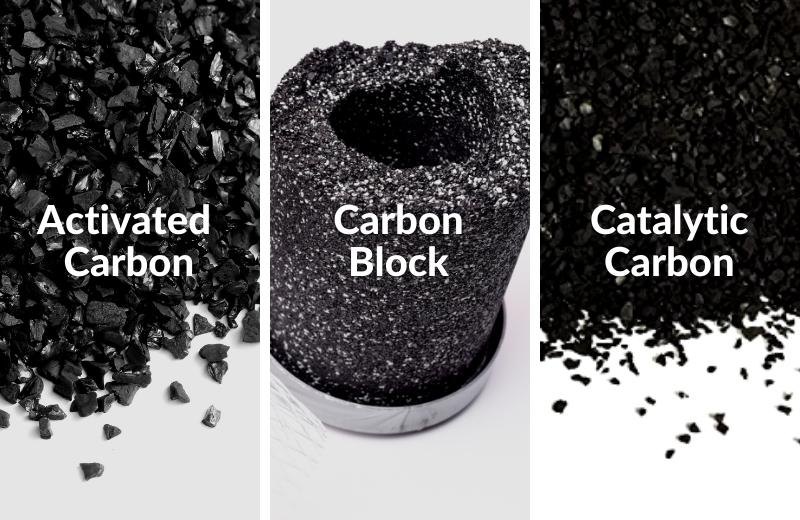
Are whole house carbon filters worth it?
Yes, whole house carbon filters are worth it if you’re keen to remove contaminants like chlorine from your entire home’s water supply, including the water you shower in, wash your clothes with, and cook with. But if you just want to remove contaminants from your drinking water, you may as well save money and buy a smaller under-sink or countertop activated carbon filter, to get the same results, but on a smaller scale.
Can you purify water with activated charcoal?
No. Activated charcoal filters water, but it doesn’t purify it. Very few filters can remove every single impurity from tap water. If you want to achieve pure water, look at reverse osmosis systems.
🤓 About Our Experts
This guide was produced by Brian Campbell, WaterFilterGuru.com’s Founder and Water Filter Specialist, and Laura Shallcross, our Senior Editor. Brian and Laura researched and reviewed our shortlisted products, and Brian tested the filters in his home. Learn more about them in their author bios below.


